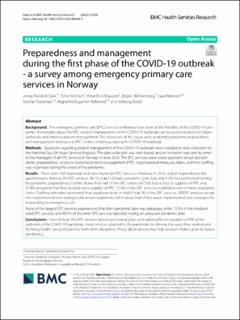| dc.contributor.author | Dale, Jonas Nordvik | |
| dc.contributor.author | Morken, Tone | |
| dc.contributor.author | Eliassen, Knut Eirik Ringheim | |
| dc.contributor.author | Blinkenberg, Jesper | |
| dc.contributor.author | Rørtveit, Guri | |
| dc.contributor.author | Hunskår, Steinar | |
| dc.contributor.author | Rebnord, Ingrid Keilegavlen | |
| dc.contributor.author | Baste, Valborg | |
| dc.date.accessioned | 2022-10-24T11:24:16Z | |
| dc.date.available | 2022-10-24T11:24:16Z | |
| dc.date.created | 2022-09-13T08:54:44Z | |
| dc.date.issued | 2022 | |
| dc.identifier.issn | 1472-6963 | |
| dc.identifier.uri | https://hdl.handle.net/11250/3027895 | |
| dc.description.abstract | Background The emergency primary care (EPC) services in Norway have been at the frontline of the COVID-19 pandemic. Knowledge about the EPC services’ management of the COVID-19 outbreak can be used to prepare for future outbreaks and improve patient management. The objectives of this study were to identify pandemic preparedness and management strategies in EPC centres in Norway during the COVID-19 outbreak. Methods Questions regarding patient management of the COVID-19 outbreak were included in data collection for the National Out-Of-Hours Services Registry. The data collection was web-based, and an invitation was sent by email to the managers of all EPC services in Norway in June 2020. The EPC services were asked questions about pre-pandemic preparedness, access to personal protective equipment (PPE), organizational measures taken, and how staffing was organized during the onset of the pandemic. Results There were 169 municipal and inter-municipal EPC services in Norway in 2020, and all responded to the questionnaire. Among the EPC services, 66.7% (n = 112) had a pandemic plan, but only 4.2% had performed training for pandemic preparedness. Further, fewer than half of the EPC centres (47.5%) had access to supplies of PPE, and 92.8% answered that they needed extra supplies of PPE. 75.3% of the EPC services established one or more respiratory clinics. Staffing with other personnel than usual was done in 44.6% (n = 74) of the EPC services. All EPC services except one implemented new strategies for assessing patients, while about half of the wards implemented new strategies for responding to emergency calls. None of the largest EPC services experienced that their pandemic plan was adequate, while 13.3% of the medium-sized EPC services and 48.9% of the small EPC services reported having an adequate pandemic plan. Conclusions Even though the EPC services lacked well-tested plans and had insufficient supplies of PPE at the outbreak of the COVID-19 pandemic, most services adapted to the pandemic by altering the ways they worked and by hiring health care professionals from other disciplines. These observations may help decision makers plan for future pandemics. | en_US |
| dc.language.iso | eng | en_US |
| dc.publisher | BMC | en_US |
| dc.rights | Navngivelse 4.0 Internasjonal | * |
| dc.rights.uri | http://creativecommons.org/licenses/by/4.0/deed.no | * |
| dc.title | Preparedness and management during the first phase of the COVID-19 outbreak - a survey among emergency primary care services in Norway | en_US |
| dc.type | Journal article | en_US |
| dc.type | Peer reviewed | en_US |
| dc.description.version | publishedVersion | en_US |
| dc.rights.holder | Copyright 2022 The Author(s) | en_US |
| dc.source.articlenumber | 896 | en_US |
| cristin.ispublished | true | |
| cristin.fulltext | original | |
| cristin.qualitycode | 2 | |
| dc.identifier.doi | 10.1186/s12913-022-08284-9 | |
| dc.identifier.cristin | 2051039 | |
| dc.source.journal | BMC Health Services Research | en_US |
| dc.identifier.citation | BMC Health Services Research. 2022, 22, 896. | en_US |
| dc.source.volume | 22 | en_US |
| dc.source.issue | 1 | en_US |

